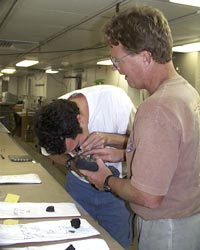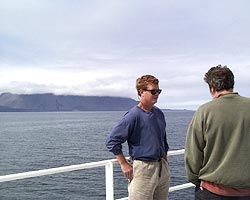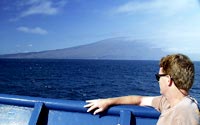|
|
Interviews: Volcanologist Dennis Geist How did you end up studying the Galápagos?
I particularly like to convince others to go on obscure expeditions to ridiculous places and sleep outside in monsoons with monitor lizards. So far it’s worked out pretty well. I’ve been studying the volcanic geology of the Galápagos Islands since 1982 and collaborating with the other expedition scientists on Galápagos geology for the last 10 years. When I’m not on expeditions collecting Galápagos lavas, I’m analyzing the samples back in my lab at the University of Idaho. Question: What is it like doing field research in the Galápagos? Denny: Research around the Galápagos has not always been as high tech as we have on this cruise. On one expedition we used a retired Ecuadorian fishing vessel to conduct our research. The boat had to rely on a hand-crank generator for power, because the batteries were dead. We were offshore of one of the more desolate of the Galápagos Islands when no one seemed to notice that the generator crank fell overboard. It was two days before they managed to contact another ship using a small jury-rigged solar panel connected to a radio. On the brighter side, we had two extra field days and we now have a great deal of geologic information pertaining to that particular coastline. Field work in the Galápagos is tough - the conditions are brutal. It’s hot and dry and there’s no water and little shade. Walking across lava flows is dangerous. On the other hand, there’s a beauty and remoteness to the area. I feel like the luckiest person in the world to have the opportunity to work here. I’ve been fortunate to have some of the best students and scientist friends working with me in the Galápagos.
What do you do outside of your work? Denny: My work takes me away from home a lot and teaching keeps me busy when I’m in town, so I mainly spend my free time with my wife Leslie Manning and daughter Beryl. My wife spent part of her college years in Kenya and Uganda. Part of the origin of our daughter’s name is from Beryl Markham, an adventurous woman in Africa during the early 20th century and the first person to fly solo from Europe to North America. Also, Beryl is a mineral, so we thought it was a great name I used to do a lot of mountain climbing. I still fly-fish and enjoy general outdoor recreation. I’m a big Seattle Mariners fan. I also watch the Simpsons. Matt Groening, the creator of the Simpsons, and I grew up in Portland, Or. Matt's sister, Lisa, and I were in the same homeroom class in high school. Question: So were you the inspiration for any of the other cartoon characters? Denny: I don’t know, some people think I might be Milhous.
What are you looking for on this expedition? Denny: I’d like to understand how the Galápagos volcanoes grow above sea level. I’m a rock guy, so I’m interested in the different volcanic mechanisms and styles of eruptions. Studying the rocks tells me where the magmas come from and how the magmas change as they rise out of the water. I’m looking to find out how the magmas are different at different volcanoes or if they are related to each other. For example, are the magmas at Volcán Ecuador similar to Wolf and if so in what ways? If they are different, why? These are the puzzles I’m trying to solve. |
||||||||||
Mailing List | Feedback | Glossary | For Teachers | About Us | Contact
© 2010 Dive and Discover™. Dive and Discover™ is a registered trademark of
Woods
Hole Oceanographic Institution

 In the Main Lab, Denny explains the topography of the area we are about to cover during our sonar surveying.
In the Main Lab, Denny explains the topography of the area we are about to cover during our sonar surveying.

